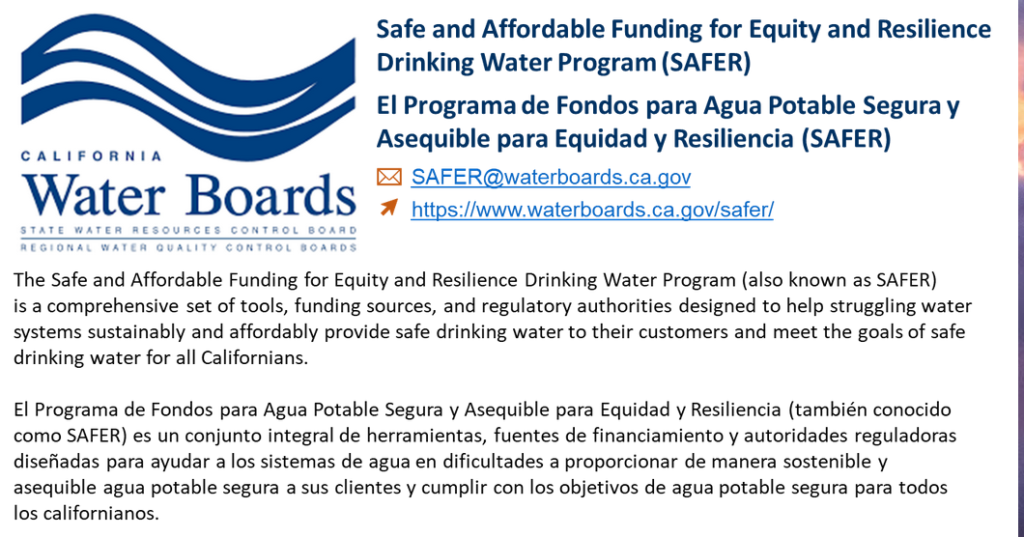A wrap-up of posts published on Maven’s Notebook this week …
Note to readers: Sign up for weekly email service and you will receive notification of this post on Friday mornings. Readers on daily email service can add weekly email service by updating their subscription preferences. Click here to sign up!
This week’s featured articles …
DELTA COUNTIES FORUM: Delta tunnel opponents express their concerns, push for alternatives
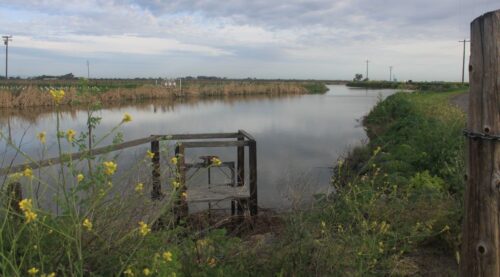 The Delta Counties Coalition (DCC) is an alliance of the California Counties of Contra Costa, Sacramento, San Joaquin, Solano, and Yolo. These counties work collaboratively to give one voice on behalf of the Sacramento-San Joaquin River Delta and its 4 million area-wide residents. The DCC advocates for three goals: to improve the Delta ecosystem, to provide a more reliable water supply for the State, and to protect and enhance Delta communities.
The Delta Counties Coalition (DCC) is an alliance of the California Counties of Contra Costa, Sacramento, San Joaquin, Solano, and Yolo. These counties work collaboratively to give one voice on behalf of the Sacramento-San Joaquin River Delta and its 4 million area-wide residents. The DCC advocates for three goals: to improve the Delta ecosystem, to provide a more reliable water supply for the State, and to protect and enhance Delta communities.
With the release of the environmental documents for the Delta Conveyance Project imminent, the Delta Counties Coalition hosted a forum in June of 2022 to air their concerns about the project and to push for alternative solutions.
Click here to read this article.
WATER STORAGE INVESTMENT PROGRAM: The Road to Final Funding
The first of seven projects could see final funding awarded by the end of the year; other projects not until 2024
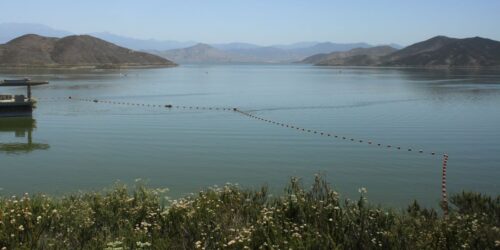 It’s a long road to the finish line for the seven water storage projects in the California Water Commission’s Water Storage Investment Program. In 2014, voters approved Proposition 1, which dedicated $2.7 billion for investments in the public benefits of water storage projects. In July 2018, the Commission determined the amount of funding available to each project based on the public benefits the project would provide. The selected projects include expanding existing reservoirs, building new reservoirs, and boosting groundwater storage.
It’s a long road to the finish line for the seven water storage projects in the California Water Commission’s Water Storage Investment Program. In 2014, voters approved Proposition 1, which dedicated $2.7 billion for investments in the public benefits of water storage projects. In July 2018, the Commission determined the amount of funding available to each project based on the public benefits the project would provide. The selected projects include expanding existing reservoirs, building new reservoirs, and boosting groundwater storage.
Since their selection, the projects have been working towards completing the remaining hurdles to receiving the funding, and the finish line is drawing closer. At the July meeting of the California Water Commission, Program Manager Amy Young presented an overview of the program’s remaining process for getting to the final award hearings.
Click here to read this article.
In California water news this week …
California outlines plan for scaled-back giant water tunnel

“A new plan to reroute how water moves from wetter Northern California to drier Southern California would ferry it through a single, 45-mile (72-kilometer) underground tunnel, wrapping around the state’s existing water delivery system and dumping the water straight into the main aqueduct that sends it south to vast swaths of farmland and millions of people. The scaled-back proposal released Wednesday would build one tunnel to take water from the Sacramento River, the state’s largest, to the California Aqueduct for delivery to millions of people and farmland further south. … ” Read more from the AP here: California outlines plan for scaled back giant water tunnel
Delta tunnel: Salmon at risk from massive water project, state report says
“California’s water agency today released a long-awaited environmental report outlining the details and impacts of a controversial proposal to replumb the Sacramento-San Joaquin Delta and pump more water south. In the report, state officials said the tunnel project could harm endangered and threatened species, including the Delta smelt, winter-run chinook salmon and steelhead trout. To offset the “potentially significant impacts” on the rare fish, the Department of Water Resources says thousands of acres of other wetlands would have to be restored — which critics say is a slow and inefficient way to provide new habitat. The draft environmental impact report is a major step in planning a tunnel that would fundamentally reshape California’s massive water management system. … ” Read more from Cal Matters here: Delta tunnel: Salmon at risk from massive water project, state report says
Delta Conveyance Project Draft EIR Available for Public Review and Comment Through October 27, 2022
“The California Department of Water Resources (DWR) has released and is now accepting comments on the proposed Delta Conveyance Project Draft Environmental Impact Report (EIR) through October 27, 2022. Everyone is invited to visit the Draft EIR website to access the document and accompanying informational resources and learn more about the proposed project and the public review process, including public hearing details and commenting opportunities. The Draft EIR was prepared by DWR as the lead agency to comply with the requirements of the California Environmental Quality Act by evaluating a range of alternatives to the proposed project and disclosing potential environmental effects of the proposed project and alternatives, and associated mitigation measures for potentially significant impacts. No decisions will be made until the conclusion of the environmental review process, after consideration of public comments submitted on the Draft EIR and issuing a Final EIR. At that time, DWR will determine whether to approve the proposed project, an alternative or no project. … ” Read the press release from DWR here: Delta Conveyance Project Draft EIR Available for Public Review and Comment Through October 27, 2022
Move afoot in Congress to block Delta tunnel project
“Tom Patti and Josh Harder — the two hopefuls that want to serve the first Congressional district to represent San Joaquin County exclusively — agree on at least one thing. The state’s Delta tunnel plan to benefit the massive Metropolitan Water District in Southern California ‘s as well as billionaire and corporate farmers in West Kern County must be stopped. Harder along with fellow Congress members Jerry McNerney and John Garamendi earlier this month introduced an amendment to prohibit the Army Corps of Engineers from issuing a Clean Water Act permit for the California Delta Conveyance Project. Their argument is the tunnel would rob the Delta of the benefit of Sacramento River water that currently flows through it on the way to the pumps at the head of the California Aqueduct northwest of Tracy. … ” Read more from the Manteca Bulletin here: Move afoot in Congress to block Delta tunnel project
Audit: State Water Resources Control Board lacks the urgency necessary to ensure that failing water systems receive needed assistance in a timely manner
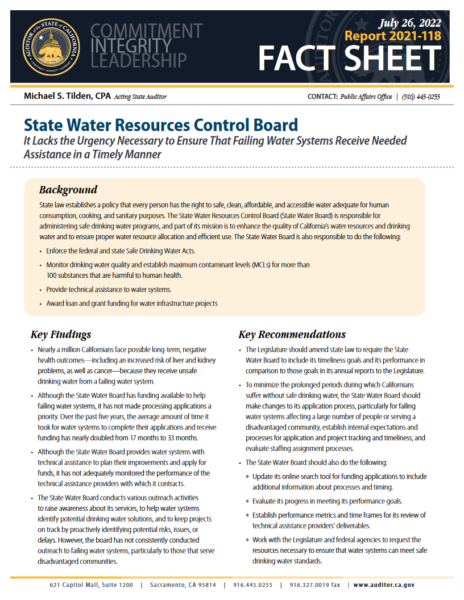 “Our audit of the State Water Resources Control Board focused on the board’s efforts to help provide Californians with safe drinking water. The State Water Board reported that more than 370 such systems, providing water to more than 920,000 people, were not meeting water quality standards as of December 2021. More than two‑thirds of these systems are located in disadvantaged communities with significant financial need. The State Water Board has funding available to help these failing systems improve the quality of their drinking water. Nonetheless, the board has generally demonstrated a lack of urgency in providing this critical assistance. In fact, the time necessary for water systems to complete applications for funding and for the State Water Board to approve and award that funding nearly doubled from 17 months in 2017 to 33 months in 2021. … ” Continue reading at the California State Auditor here: State Water Resources Control Board lacks the urgency necessary to ensure that failing water systems receive needed assistance in a timely manner
“Our audit of the State Water Resources Control Board focused on the board’s efforts to help provide Californians with safe drinking water. The State Water Board reported that more than 370 such systems, providing water to more than 920,000 people, were not meeting water quality standards as of December 2021. More than two‑thirds of these systems are located in disadvantaged communities with significant financial need. The State Water Board has funding available to help these failing systems improve the quality of their drinking water. Nonetheless, the board has generally demonstrated a lack of urgency in providing this critical assistance. In fact, the time necessary for water systems to complete applications for funding and for the State Water Board to approve and award that funding nearly doubled from 17 months in 2017 to 33 months in 2021. … ” Continue reading at the California State Auditor here: State Water Resources Control Board lacks the urgency necessary to ensure that failing water systems receive needed assistance in a timely manner
Audit: Nearly a million Californians lack access to safe drinking water
“Nearly a million people living in California use water from a “failing water system,” according to a state audit published Tuesday, exposing them to a range of negative long-term health outcomes including an increased risk of cancer and liver and kidney problems. The California State Water Resources Control Board classifies 418 local water systems as “failing,” meaning their water supply exceeds the maximum allowable contaminant levels for safe drinking water. More than 920,000 people rely on drinking water from those systems. Nearly 240 systems have been failing for three years or more. An additional 432 water systems, serving more than 1 million people, are “at risk of failing.” … ” Read more from the Courthouse News Service here: Audit: Nearly a million Californians lack access to safe drinking water
State Water Board’s SAFER program responds to State Auditor report
 “On Tuesday, July 26, the State Auditor’s office released a report on an audit it conducted of the State Water Board’s drinking water assistance efforts. This email intends to provide more information on our drinking water assistance efforts, our response to the audit, and on the outcomes that have been accomplished over the last 3 years. Last year, the Joint Legislative Audit Committee requested an audit of the State Water Resource Control Board’s efforts to help provide Californians with clean drinking water. The report from the State Auditor suggested that the State Water Board lacks urgency in delivering needed assistance, citing long process times, and the State Auditor included a number of recommendations to improve processes/procedures. The State Water Board disagrees with the report’s framing that the board lacks urgency in providing assistance to communities and agrees to continue to build upon opportunities to improve how it delivers assistance to communities most in need. ...
“On Tuesday, July 26, the State Auditor’s office released a report on an audit it conducted of the State Water Board’s drinking water assistance efforts. This email intends to provide more information on our drinking water assistance efforts, our response to the audit, and on the outcomes that have been accomplished over the last 3 years. Last year, the Joint Legislative Audit Committee requested an audit of the State Water Resource Control Board’s efforts to help provide Californians with clean drinking water. The report from the State Auditor suggested that the State Water Board lacks urgency in delivering needed assistance, citing long process times, and the State Auditor included a number of recommendations to improve processes/procedures. The State Water Board disagrees with the report’s framing that the board lacks urgency in providing assistance to communities and agrees to continue to build upon opportunities to improve how it delivers assistance to communities most in need. ...
California drought official quits, blasting Newsom for ‘gut wrenching’ inaction
“In his time at the California State Water Resources Control Board, Max Gomberg has witnessed the state grapple with two devastating droughts and the accelerating effects of climate change. Now, after 10 years of recommending strategies for making California more water resilient, the board’s climate and conservation manager is calling it quits. The reason: He no longer believes Gov. Gavin Newsom and his administration are willing to pursue the sorts of transformational changes necessary in an age of growing aridification. … ” Read more from the LA Times here: California drought official quits, blasting Newsom for ‘gut wrenching’ inaction | Read via AOL News
Water woes are biggest worry for Californians as drought drags on
“As the drought punishing California drags on, water is a top — and growing — worry for residents of our parched state, outpacing wildfires and climate change, according to a new poll about environmental issues. With reservoirs and snowpack shrinking, Californians listed the state’s water supply as their number one environmental worry, with 68% of adults saying it’s a big problem — up from 63% a year ago. But while most have water on their minds, fewer than half said they have done a lot to reduce their water use, and 16% say they have done nothing. At the same time, people are pointing fingers at their neighbors — 69% of Californians said people in their area are not doing enough to conserve. … ” Read more from the San Jose Mercury News here: Water woes are biggest worry for Californians as drought drags on
Feds double water supply for Valley farms, cities
“More water will flow into farms and cities on the Valley’s east side after a decision by the federal government to increase the supply streaming down canals. On July 20, the U.S. Bureau of Reclamation (USBR) announced it will increase the water supply delivered to contractors along the eastern side of the Valley to 30%, doubling the original allocation of 15% announced in February. The amount of Class 1 water, for contractors with first rights for water deliveries, was confirmed by Friant Water Authority, which operates the Friant-Kern Canal, in a July 22 update on its website. ... ” Read more from the Foothills Sun-Gazette here: Feds double water supply for Valley farms, cities
Mono Lake was supposed to have been saved from going dry. Now, the ‘white stuff’ forces a reckoning
“The few who live along the shores of Mono Lake are accustomed to the peculiarities of this high desert basin. Famously strange limestone spires known as tufa towers rise from the water. The lake contains so much salt that it’s barren of fish. In the arid sands beyond, sagebrush thrives, and that’s about it. But the alkali flats that are emerging from the lake’s surface, ghost white, aren’t just another nod to the uniqueness of this ancient place. They’re a sign of trouble. Amid a third year of drought, the sprawling lake on the remote east side of the Sierra Nevada is sharply receding, and the small towns and wildlife so closely tied to the water are feeling the pinch. … ” Read more from the San Francisco Chronicle here: Mono Lake was supposed to have been saved from going dry. Now, the ‘white stuff’ forces a reckoning
Senator Feinstein: Water bill includes $375 million for California projects
“Senator Dianne Feinstein (D-Calif.) today released the following statement in support of the Water Resources Development Act: “Water is the lifeblood of California. This bill recognizes that fact and invests in maintaining our water supply, restoring our environment and protecting our communities from extreme weather and pollution. The bill authorizes funding to remove harmful chemicals from our drinking water, prevent major flooding in our communities and reaffirm the federal government’s commitment to saving Lake Tahoe and the San Francisco Bay. The bill also helps make us more resilient against the increasing effects of climate change. California, like most of the West, is experiencing a historic drought due to climate change, and this bill includes significant funding to help us recover and better prepare for these dry conditions. “I’m pleased that so many of California’s priorities are included in this bill, and I’m proud to support it in the Senate.” … ” Read more from Senator Feinstein’s office here: Water Bill Includes $375 Million for California Projects
Department of Water Resources talks Oroville Dam following 4.2 earthquake
“A recent earthquake in the Oroville area has many wondering how stable the Oroville Dam is. The Department of Water Resources told Action News Now the Dam is in good condition and was not damaged by the 4.2 earthquakes. Many people in Oroville said they’ve experienced several earthquakes but are always on alert when a fire or earthquake happens, especially after the Oroville Spillway Crisis in 2017. The crisis pushed nearly 190,0000 people to evacuate but the DWR said the Dam can withstand a lot and is constantly being evaluated in case an emergency breaks out. … ” Read more from Action News Now here: Department of Water Resources talks Oroville Dam following 4.2 earthquake
In commentary this week …
Opinion: If our Colorado River water supply is cut, prepare to see empty shelves at the grocery store
Mike Wade, executive director of the California Farm Water Coalition, writes, “When you go to the grocery store and fill the cart with food for your family, you are part of a long process that begins with soil, water, sunlight and the labor of farmers and farm workers. Most likely, the farms that grow most of your food are in a neighboring rural area or within a day’s drive from your home. California grows 61 percent of U.S.-produced fruits, nuts and vegetables. Many of our winter fruits and vegetables come from the Imperial and Coachella valleys as well as from the San Joaquin, Salinas and Sacramento valleys the remainder of the year. There is a connection between water resources, farmers who know the land and the consumer who trusts in our safe, domestic food supply. But that connection is at risk from the threat of lopsided policy, and once grocery store shelves are empty, it will be too late. ... ” Read more from the San Diego Union-Tribune here: Opinion: If our Colorado River water supply is cut, prepare to see empty shelves at the grocery store
Want to fight climate change and drought at the same time? Bring back beavers
Chris Jordan, mathematical biology and systems monitoring program manager at NOAA Fisheries’ Northwest Fisheries Science Center, and Emily Fairfax, an assistant professor of environmental science and resource management at Cal State Channel Islands, write, “Millions of highly skilled environmental engineers stand ready to make our continent more resilient to climate change. They restore wetlands that absorb carbon, store water, filter pollution and clean and cool waters for salmon and trout. They are recognized around the world for helping to reduce wildfire risk. Scientists have valued their environmental services at close to $179,000 per square mile annually. And they work for free. Our ally in mitigating and adapting to climate change across the West could be a paddle-tailed rodent: the North American beaver. ... ” Read more from the LA Times here: Want to fight climate change and drought at the same time? Bring back beavers
Why murdering overgrown swamp rats is the environmental success California deserves
Josh Gohlke, Deputy California Opinion Editor for McClatchy and The Sacramento Bee, writes, “Nothing describes the nutria’s shortage of animal magnetism so well as its genus, Myocastor, which can be translated from the Latin as “rat beaver.” Along with the large rodent’s capacity to devastate environments and infrastructure alike, its just-plain-unsightliness lends palatability to a government project that might otherwise be regarded as unseemly: exterminating them with extreme prejudice. After five years and against difficult odds, the California Department of Fish and Wildlife’s campaign to wipe this particular wildlife off the map could be grimly succeeding, as The Bee reported last week. If this does turn out to be an unlikely and impressive environmental victory, it will also be a strange and grisly one befitting our age of ecological upheaval and destruction. ... ” Read more from the Sacramento Bee here: Why murdering overgrown swamp rats is the environmental success California deserves
Commentary: A bad bill undermines cooperation on groundwater
Danny Merkley, director of water resources for the California Farm Bureau, and Jack Gualco, president of The Gualco Group Inc, writes, “The California Department of Water Resources has not finished evaluating Groundwater Sustainability Plans submitted by local agencies under SGMA, which established a cooperative framework to protect California’s groundwater resources. But already legislation—Assembly Bill 2201 by Steve Bennett, D-Ventura—seeks to change SGMA in ways that would bring unnecessary confusion and disruption into the process. The bill, which passed in the Assembly and is now in the state Senate, would prohibit a local groundwater well permitting agency from approving a permit for a new groundwater well, or for an alteration to an existing well in a basin subject to SGMA, unless it receives written verification from the local Groundwater Sustainability Agency that manages the basin. … ” Read more from Ag Alert here: Commentary: A bad bill undermines cooperation on groundwater
San Joaquin Valley’s next big air pollution threat: Blowing dust from fallowed farmland
Andrew Ayres, a research fellow at the PPIC Water Policy Center, and Jaymin Kwon, associate professor of environmental health at Fresno State, write, “The San Joaquin Valley has faced air quality problems for decades. It is a major transportation thoroughfare and has historically been prone to particulate matter and dust issues that are often worsened by high-wind events and a pollution-trapping topography. In recent decades, particulate matter concentrations have decreased — though wildfires have recently reversed some gains. But the Valley is now facing another threat to air quality: the impending retirement of hundreds of thousands of acres of irrigated farmland to achieve groundwater sustainability. It’s imperative that regional, state, and federal actors take proactive measures to address these risks early. ... ” Read more from the Fresno Bee here: San Joaquin Valley’s next big air pollution threat: Blowing dust from fallowed farmland
Drought revives Mississippi River pipe dreams
“The ongoing drought in the West has revived old pipe dreams. Readers of the Desert Sun newspaper in Palm Springs, Calif., have been conducting a debate, via guest editorials and letters to the editor, about the desirability of piping Mississippi River water out west to relieve chronic droughts. On June 30, reader Don Siefkes wrote a guest editorial with the title, “We could fill Lake Powell in less than a year with an aqueduct from Mississippi River.” He proposed a pipeline direct from the Old River Control Structure in Louisiana, with windmills along the route boosting the pumping power. That contribution sparked a lot of responses, pro and con. One reader worried that piping Mississippi River water west could bring in invasive species. More to the point, towboatman Matt Crea of Maple Grove, Mo., responded that the Mississippi River needs that water to support navigation. ... ” Read more from the Waterways Journal here: Drought revives Mississippi River pipe dreams
As an engineer, here’s how I look at the idea of pumping water from Mississippi to the West
John Homer, a professional engineer working in retirement as a consultant on construction projects, writes, “At an age when my classmates were fascinated with dinosaurs or playing Cowboys and Indians, I picked up a book titled “Engineers’ Dreams” and was hooked. Thus began a lifelong interest in projects associated with engineering concepts about improving our world. The author, Willy Ley, sketched the outlines of some large civil projects including the development of the Channel Tunnel connecting Britain with France. Of course, the tunnel has been in use for 28 years. He also explored ideas for generating electricity. With solar and wind power leading the way, every one of his generation schemes has seen significant development since. Given my interests, I was drawn to a recent letter in The Desert Sun proposing to solve the shortage of water in the Southwest by bringing water from the Mississippi River. … ” Read more from the Desert Sun here: As an engineer, here’s how I look at the idea of pumping water from Mississippi to the West | Read via Yahoo News
SEE ALSO: The West, and some Midwest farmers too, are in a water crisis. I suggest we call Bill Gates, from the Desert Sun | Read via Yahoo News
In regional water news this week …
The Klamath Tribes and Klamath Water Users Association urge Reclamation to complete a new Endangered Species Act consultation
“The existing Interim Operations Plan expires on 30 September 2022. Everyone agrees the IOP is flawed, unworkable, and that an extension would be neither in the public interest nor conducive to reducing conflict in the Klamath Basin. “We do not presume that a new consultation will be perfect or that we will find nothing objectionable in the outcome. But it does not serve the Klamath Basin, its communities, or its fish and wildlife to continue…to operate under the IOP.”
Fates of fish and flow of the Eel River still uncertain
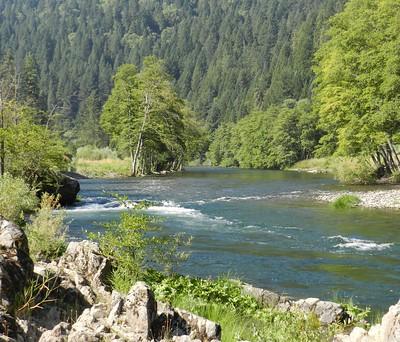 “The Potter Valley Project is a century-plus-old hydroelectric plant north of Ukiah. Owned by Pacific Gas and Electric, it transfers water from the Eel River to the Russian River, providing drinking water to many in Sonoma County. But big changes are on the way. “Everyone who is a PG&E customer is currently paying PG&E to run these facilities, kill fish and not determine the proper solution.” Redgie Collins said. “They need to step up to the plate and be the stewards in the environment that they claim to be in order to move this process as quickly as possible.” That’s how Collins, with the conservation group California Trout, described PG&E’s handling of the Potter Valley Project. Cal Trout’s criticism follows a letter to federal agencies claiming PG&E fails to protect endangered salmon and trout populations in the Eel River, below the dams of the Project. … ” Read more from Northern California Public Media here: Fates of fish and flow of the Eel River still uncertain
“The Potter Valley Project is a century-plus-old hydroelectric plant north of Ukiah. Owned by Pacific Gas and Electric, it transfers water from the Eel River to the Russian River, providing drinking water to many in Sonoma County. But big changes are on the way. “Everyone who is a PG&E customer is currently paying PG&E to run these facilities, kill fish and not determine the proper solution.” Redgie Collins said. “They need to step up to the plate and be the stewards in the environment that they claim to be in order to move this process as quickly as possible.” That’s how Collins, with the conservation group California Trout, described PG&E’s handling of the Potter Valley Project. Cal Trout’s criticism follows a letter to federal agencies claiming PG&E fails to protect endangered salmon and trout populations in the Eel River, below the dams of the Project. … ” Read more from Northern California Public Media here: Fates of fish and flow of the Eel River still uncertain
Initial results of herbicide use in Tahoe Keys promising
“Initial observations of the Tahoe Keys Aquatic Invasive Species Controls Method Test shows promise but the test is far from over. The first of a three year methods test is two months underway and scientists are already seeing promising results. The CMT is testing several different methods to knock-back aquatic invasive species over the next three years. Applications of herbicides began on May 25 and wrapped up on May 31, the same day UV light treatments began. … ” Read more from the Tahoe Daily Tribune here: Initial results of herbicide use in Tahoe Keys promising
Concrete river: Water, life, pollution, and the future of the Los Angeles River
“Today, the L.A. River is at a pivot point. Development, pollution, and poor management are significant threats to the river’s health. Earlier this year the environmental group American Rivers ranked the L.A. River as the 9th most endangered river in the country. In its recent history, the river has been abused by its urban setting, channelized and tainted with industrial runoff. But along its northern reaches, a restoration is taking shape. The L.A. River Master Plan, which aims to improve the profile of the river over the next 25 years, was approved by Los Angeles County officials in May. The plan seeks to renovate around river-adjacent communities that have historically been harmed by racial, environmental, and institutional injustices. These communities are also some of Southern California’s poorest and most polluted. Environmentalists, however, have voiced their concern over certain elements in the Master Plan. … ” Read more from the Circle of Blue here: Concrete river: Water, life, pollution, and the future of the Los Angeles River

